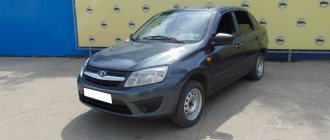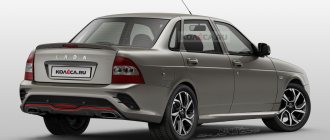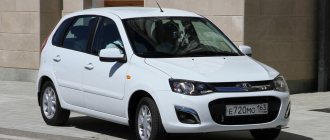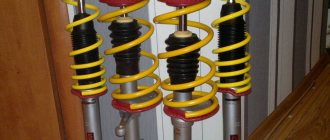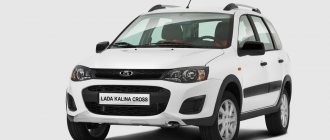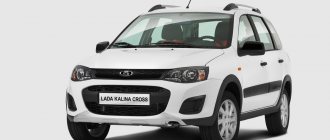Two models of the domestic manufacturer Kalina and Priora have already proven themselves in the CIS market. These cars are representatives of the same price segment and act as competitors to each other. Consequently, the buyer is left with the question of which is better, Kalina or Priora, because both cars can be purchased at a similar price.
When choosing, you need to study the characteristics, user reviews and compare data to give the most fair assessment.
Content
- "Priora" or "Kalina": classification problems
- "Kalina" or "Priora": what about the equipment?
- Motors and transmissions
- So which is better in the end - Kalina or Priora?
- Condition and choice of Lada Priora and Lada Kalina
At first glance, the question sounds like “do you want black or green tea?” On the second one, actually, too. Before the arrival of foreign engineers and managers, VAZ riveted surprisingly identical cars, even if they formally belonged to different classes.
On the secondary market, the second Kalina and the first generation restyled Priora cost almost the same - 314 and 312 thousand rubles, respectively. Offers for them are also almost at the same level - 140-155, but Priora is most often bought and sold. In May, it was checked 22,730 times through avtocod.ru, placing it in second place among all models. “Kalina” ended up in 16th place with 12,997 checks. What is better to buy on the secondary market - Priora or Kalina, let's figure it out.
EQUIPMENT
Initially, both models were equipped with three trim levels: “standard”, “norm” and “luxury”. A little later, Priora got rid of the “standard” package, leaving instead the “norm” package, since it was clearly better. The main indicators of any configuration are a number of necessary and additional options, such as:
By considering each of these functions separately, you can determine which car will be better.
Let's start with security. Both cars have a passive safety feature in the form of airbags. The only difference is that Lada Kalina has 2 airbags - driver and passenger, and Priora has only one - driver's. At the same time, it has a much better brake system. In addition to the standard set of ABS, exchange rate control and TCS, the Lada Priora is equipped with an additional cooling system for brake discs.
Also, in addition to cooling the brakes, this model is equipped with additional body reinforcements that can reduce the degree of deformation in the event of a collision. The seat belts are the same on both models, with a pre-tensioning system.
As for additional comfort, Kalina is significantly inferior to its opponent. For example, it lacks an on-board computer and a climate control system. The latter has been replaced by a standard set: stove and air conditioning.
Also, in order for the Priora engine to start better when cold, pre-heating of the fuel is provided in the “Normal” and “Lux” trim levels. Both cars, in all trim levels, are equipped with electric windows and a built-in alarm.
"Priora" or "Kalina": classification problems
The word “problem” will generally accompany us throughout the text, and it begins already when determining what is in front of us.
Formally, Kalina is a European B-class, Priora is closer to a C-class. In fact, the difference in dimensions is nominal:
- top-end Kalina station wagon - 4.11 m in length;
- Priora with the same body type - 4.21 m.
At the same time, it is absolutely unclear where the extra decimeter of space went.
In terms of the amount of space in the cabin, it is also unclear which class is which: low seating, minimal gap between the rows of seats - in both cars only short and hardy people can sit in the back for a long time. That is, Mongolian steppe riders.
And it’s even funnier that in both Kalina and Priora, the body type has almost no effect on anything. It’s usually the same: a sedan has a spacious, but most inconvenient trunk, a station wagon is the opposite: it has the maximum displacement and ease of use.
What about LADA? The trunk of a station wagon is not the most spacious, but the most spacious is that of the Granta co-platform liftback (after restyling, this became one family, which makes it even funnier).
The Priora has no difference at all in terms of practicality between body types: both the liftback and the station wagon have 360 liters each behind the rear sofa.
In short, the difference is purely aesthetic. There is no point in looking for a “Kalina station wagon” or a “Priora station wagon” in the hope of seeing space and capacity there.
Also read: Focus on Priora or priority on Accent? Comparing two budget bestsellers
Luggage compartment capacity
Of course, a person who buys a station wagon hopes that the trunk of his car will be much larger than that of a hatchback or sedan, and in most cases it is this factor that plays a decisive role. If you choose a vehicle based on only one parameter, then your car is a Priora, since it is longer than the Kalina 2 in the same body and it will fit more cargo.
If we talk about the Kalina station wagon, even representatives of AvtoVAZ often say that in fact this type of body can be called a full-fledged hatchback.
"Kalina" or "Priora": what about the equipment?
Until the second half of the 2000s it was very bad. AvtoVAZ is slow to introduce innovations, so their cars reached more or less European levels (early 90s) only in 2013. It was then that both Kalina and Priora received (all or separately) airbags, ESP, heated windows, air conditioning, automatic transmission (Kalina), a media system with navigation and support for SD cards.
Everything before 2013 is pain, poverty and mud: the list of options included ESD (periodically jamming) and ABS.
The restyling of the 13th year also had a positive effect on the visual component: the plastics are still just as cheap, but at least the parts are neat; The climate control unit, for example, has become similar to a Volkswagen one from the early 2000s. Which is actually a compliment.
So it doesn’t matter what to watch - Kalina or Priora, as long as it’s after the 2013 release.
Also read: Which is better: “Granta” or “Kalina 2”
For Lada Granta liftback:
Length 4246 mm (after restyling - 4250 mm); Width 1700 mm; Height 1500 mm; Wheelbase 2476 mm; Front track width 1430 mm; The rear track width is 1414 mm.
The body dimensions of the two models are approximately the same (except that the Granta is taller), but the Granta looks larger than the Priora due to the raised hood and wider radiator grille. In the liftback body, the trunk lid turns into a mixture of the fifth door of a hatchback and the trunk door of a sedan, due to which it looks a little higher than Grants in other bodies. The Granta's wheelbase is about 1.5 cm longer, which is not so noticeable on the road - the cars are equally good off-road.
Motors and transmissions
You shouldn’t expect variety from VAZ - this is not an Audi, they didn’t deliver a range of engines. In both cases, the choice comes down to different variations of the 1.6-liter unit: 8- or 16-valve with output of 87, 98 or 106 hp. With.
There are nuances in the boxes. Thus, Kalina and Granta were equipped with an old but honest four-band automatic transmission from the Japanese Jatco. It was combined only with the 98-horsepower version of the engine. Unlike the VAZ AMT on the Kalina and Priora, it was combined only with the top-end 106-horsepower engine.
Which, however, is obvious: a car with a “robot” doesn’t drive very well anyway, here at least you can compensate for delays and interruptions in the power flow with the maximum possible number of “horses”.
And in general, the “robot” is suitable for leisurely and picky people: shifts are long, the ride is not smooth. It is not surprising that AMT accounted for not even a third of sales of the new Kalin and Prior.
But Priora buyers have no alternative: the automatic machine belongs to the Kalina/Granta family, and it is good, minus a couple of nuances. Firstly, the dynamics with automatic transmission are very conditional (0-100 in 13.1 seconds); secondly, fuel efficiency (urban cycle - more than 10 liters per 100 km). But the comfort of movement, especially in traffic jams, is incomparably greater.
Also read: Battle of the weakest: Datsun on-DO vs Lada Granta
Appearance
In principle, it is quite difficult to judge here, because there are no comrades according to taste and color. At the same time, most agree that Priora is a more youthful and modern option.
On the other hand, some believe that Kalina’s design is more elaborate. In general, you need to look here for yourself.
So which is better in the end - Kalina or Priora?
A direct comparison of the Lada Priora and the Lada Kalina shows that there is nothing special to compare. Before us are two budget front-wheel drive vehicles, rooted in the design of the “eight” and “tens”. They are nominally different in size, do not differ at all in internal volumes, largely overlap in terms of equipment, and only the “two-pedal” versions are truly different.
There is an opinion that Priora is more aerobatic and sharper. At the same time, it is Kalina that is most often used as a blank for rally and race cars. Priora also seems to look more “boyish”, especially with pneuma and xenon. But these are matters of taste and internal tolerances, not technology and design.
For the average consumer with a couple of hundred thousand in his pocket, Kalina and Priora are all the same. We look at where the condition is better, then we take it.
Also read: My first car: comparison of Granta, Logan and Nexia
Salon
When choosing between Priora and Granta, one cannot help but discuss the interior. In the Priora there is much less space than in the Grant, but the contents are different - even in the days of the pre-restyling version, the Priora had a good center console, which would “wipe the nose” of the pre-restyling Grant, but the seats in the Grant were better than in the Priora.
Restyling of the Priora in 2013 gave the car comfortable seats with slight lateral fixation (in the manner of sports cars), as well as a modern multimedia system in the maximum configuration. The multimedia display on the maximum configuration of Grants, according to reviews from owners, does not immediately respond to presses. Granta can boast of comfortable seats even in the first generation. In the restyled version, the basic player began to vaguely resemble the new Renault Logan.
Chassis, ground clearance
The Priora has a ground clearance of 165 mm in the pre-facelift version and 170 mm in the restyled version. The chassis is extremely simple: the front suspension is independent spring, the rear suspension is semi-independent spring. There are ventilated disc brakes at the front and drum brakes at the rear.
For the Granta in the liftback body, the ground clearance in the pre-restyling version was 160 mm, in the restyled version it was 190 mm. The Granta has an independent spring suspension at the front, made by McPherson, and a semi-independent spring at the rear. New front strut supports were installed, the longitudinal angle of the strut was increased and the anti-roll bar was modified. The front brakes are ventilated disc brakes, the rear brakes are drum brakes.
Both front-wheel drive cars are city cars, and in terms of cross-country ability in rural areas, the Lada Priora is still inferior to the restyled Granta liftback. Thanks to the improved suspension and higher ground clearance, the restyled Grant passes through bumps and holes better than the pre-restyling version.
Trunk
In a hatchback, the body is one-volume, since the trunk is not separated from the passenger compartment. Its cover is an additional door. This makes loading and unloading easier and makes it possible to get inside the car if, say, the locks of other doors freeze in winter. On the other hand, its opening quickly cools the air inside the car. Since the luggage compartment does not have sufficient sound insulation, the overall noise level inside the car increases. This is also facilitated by the knocking of the rear shelf, which appears when it is not securely fastened.
Despite the fact that the useful volume of the trunk in this case (here it is only 360 liters) is much lower than that of the sedan, with the rear seats folded down its volume almost doubles - to 705 liters. The rear seats, depending on the size of the cargo, can be folded either completely or partially. It becomes possible to transport large cargo: strollers, refrigerators, skis, garden tools, etc., which makes it practical in many cases.
Now let's look at: Priora sedan or hatchback, which is better in terms of other characteristics.
General characteristics in different cars
The family of VAZs under consideration is presented in sedan, hatchback and station wagon body styles. Priora and Kalina are produced with the “Standard”, “Norma” and “Lux” configurations. The difference is the price and the availability of additional features.
The “Standard” includes only the essentials for movement. Electric power steering and central locking are installed here. Only audio preparation has been completed. Power windows - front.
“Norma” is equipped with power steering, a security alarm, 14-inch wheels and minor options.
Well, in the “Lux”, electric windows are installed for all windows, and headrests are already present in the rear seats. Airbags will deploy for the driver and front passenger. Fog lights, heated seats, multimedia and navigation system, alloy wheels, ABS, air conditioning are also in the “Lux” package.
Each model reviewed has a front-mounted engine with a displacement of 1,596 cc. Fuel tank – 50 l. For refueling you need A-95 gasoline. The front suspension is independent, the rear is semi-independent. The car has 5 passenger seats. Manual Transmission.
Emission standards for modern cars of this line are Euro-5. This means that you can ride around European countries without any problems. The same cannot be said about first generation cars. They have a toxicity standard of Euro-3.
